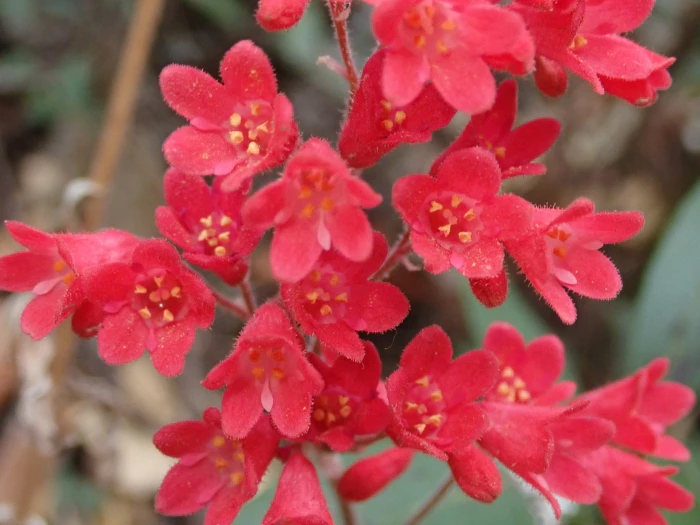Coral Bells
(Heuchera sanguinea)
Coral Bells (Heuchera sanguinea)
/
/

Nolan Exe
CC BY 4.0
Image By:
Nolan Exe
Recorded By:
Copyright:
CC BY 4.0
Copyright Notice:
Photo by: Nolan Exe | License Type: CC BY 4.0 | License URL: http://creativecommons.org/licenses/by/4.0/ | Rights Holder: Nolan Exe | Publisher: iNaturalist | Date Created: 2021-04-28T01:33:15-07:00 |




































































Estimated Native Range
Climate Requirements for Suffolk, Virginia
| This Plant | Your Site | Plant Suitability for Your Location | ||
|---|---|---|---|---|
| • Precipitation | 10" - 79" | 48" | Aquatic | Aquatic |
| • High Temp. | 60°F - 101°F | 88°F | Your summer temperatures are normal for this plant. | Excellent |
| • Low Temp. | 4°F - 45°F | 30°F | Your winter temperatures are normal for this plant | Excellent |
This plant may not grow well at your location - your precipitation is too high.
Summary
Heuchera sanguinea, commonly known as Coral Bells, is a perennial herb native to the rocky slopes and woodlands of the southwestern United States, specifically Arizona and New Mexico, as well as northern Mexico. It typically grows to a height of 2 feet and a width of 0.8-1 feet. The plant forms a low-growing foliage mound with a striking display of deep pink to red, bell-shaped flowers that are sweetly fragrant and bloom from late spring to early summer. The specific epithet ’sanguinea’ refers to the blood-red color of the flowers, which are particularly attractive to bees and hummingbirds.
Coral Bells are valued for their vibrant flowers and low maintenance, making them a popular choice for border plantings, rock gardens, and as ground cover. They are also used in container gardening and urban landscapes. The plant thrives in full sun to part shade and prefers well-drained soils. While it requires medium amounts of water, it is somewhat drought-tolerant once established. Numerous cultivars offer a variety of foliage colors and patterns, adding to its ornamental appeal. Gardeners should be aware of potential problems such as root rot in poorly drained soils and foliar diseases in humid conditions.CC BY-SA 4.0
Coral Bells are valued for their vibrant flowers and low maintenance, making them a popular choice for border plantings, rock gardens, and as ground cover. They are also used in container gardening and urban landscapes. The plant thrives in full sun to part shade and prefers well-drained soils. While it requires medium amounts of water, it is somewhat drought-tolerant once established. Numerous cultivars offer a variety of foliage colors and patterns, adding to its ornamental appeal. Gardeners should be aware of potential problems such as root rot in poorly drained soils and foliar diseases in humid conditions.CC BY-SA 4.0
Plant Description
- Plant Type: Herb
- Height: 1-1.5 feet
- Width: 1-2.5 feet
- Growth Rate: Moderate
- Flower Color: Pink, Red, White
- Flowering Season: Spring
- Leaf Retention: Evergreen, Semi-Deciduous
Growth Requirements
- Sun: Full Sun, Part Shade
- Water: Medium
- Drainage: Fast, Medium
Common Uses
Bank Stabilization, Bee Garden, Bird Garden, Border Plant, Butterfly Garden, Deer Resistant, Drought Tolerant, Fire Resistant, Fragrant, Groundcover, Hummingbird Garden, Low Maintenance, Potted Plant, Rabbit Resistant, Rock Garden, Salt Tolerant, Showy Flowers, Street Planting
Natural Habitat
Rocky slopes and woodlands in the southwestern United States and northern Mexico
Other Names
Common Names: Blut-Purpurglöckchen, Korallikeijunkukka, Heuchera Sanguin, Blodalunrot, Gewoon Purperklokje
Scientific Names: Heuchera sanguinea, Heuchera townsendii, Heuchera sanguinea var. sanguinea, Heuchera sanguinea var. typica, Heuchera sanguinea f. hirtella
GBIF Accepted Name: Heuchera sanguinea Engelm.